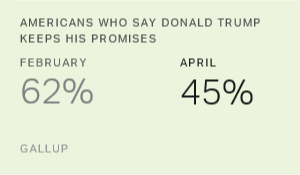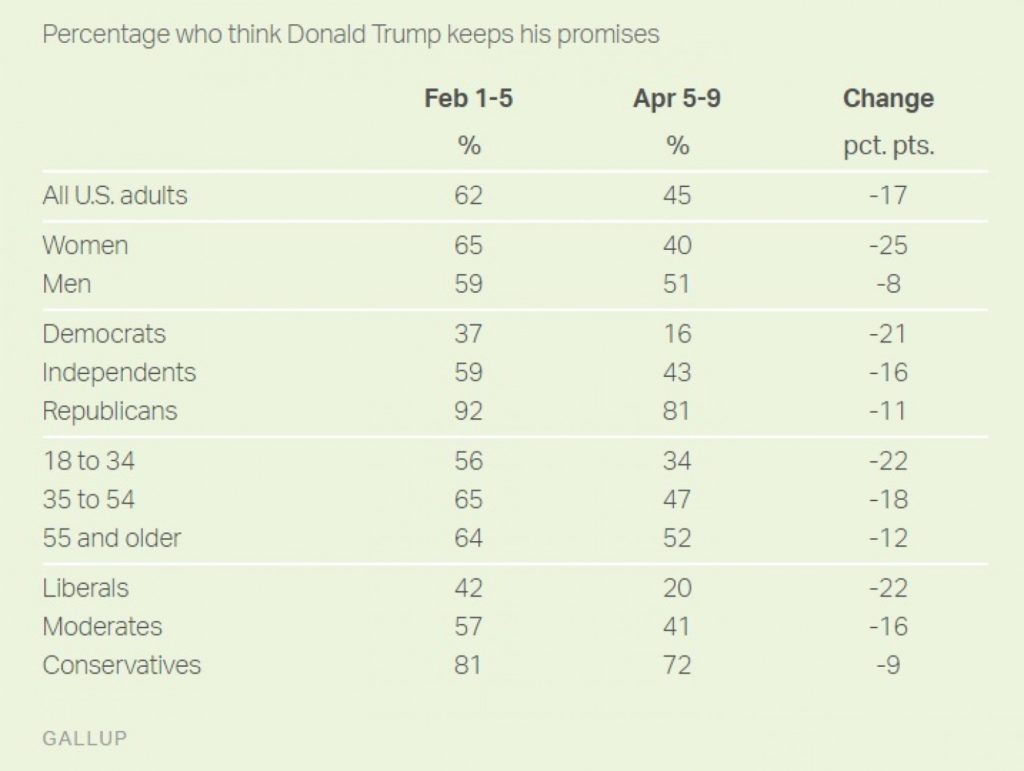
Majority in U.S. no longer think Trump keeps his promises

WASHINGTON, D.C. — President Donald Trump’s image among Americans as someone who keeps his promises has faded in the first two months of his presidency, falling from 62% in February to 45%. The public is also less likely to see him as a “strong and decisive leader,” as someone who “can bring about the changes this country needs” or as “honest and trustworthy.”

Over the past two months, Trump’s ratings have declined at least marginally on all six characteristics that Gallup measured in its April 5-9 poll. The percentages saying he cares about the needs of people like themselves and that he can manage the government effectively slipped three to four percentage points, but the changes are not statistically significant.
With close to two-thirds of Americans saying in February that Trump “keeps his promises,” it was clearly a strength for the president. Given the sharp decline on that dimension this month, that is no longer the case. In February, a majority also said Trump can bring about the changes the country needs, but less than half hold that view now. Being a strong and decisive leader is the only characteristic that a majority still say applies to Trump.
On four of the measures, between 41% and 46% of the public now thinks they apply to Trump. Those percentages are closely in line with views on two fundamental attitudes about Trump that have changed little in the past two months:
- His approval rating was at 42% when the February poll was finished; approval was around 40% in Gallup’s Daily tracking poll during the April 5-9 poll.
- 46% rated him favorably in the February poll; 45% did so this month.
The more positive assessments of Trump in February came as he started his presidency with a flurry of executive orders and Cabinet appointments. Regardless of whether they agreed with those actions, Americans appeared to take them as evidence Trump was keeping his campaign pledges to fundamentally alter the course of the federal government.
In the two months since, however, Trump appeared to walk away from repealing the Affordable Care Act after Republicans failed to agree on the healthcare replacement bill that Trump stood behind. Political friends and foes alike have complained that Trump is not carrying out the promises he made on the campaign trail. Supporters have expressed unhappiness that more has not been done on taxes and immigration, in addition to healthcare. Opponents say he has not protected middle- and working-class Americans.
Biggest Shifts Occur Among Groups Not Favorable Toward Trump
Whether young or old, Democrat or Republican, male or female, Americans are less likely now than they were two months ago to think Trump keeps his promises. But the declines have been greater among subgroups that tend to be less supportive of Trump, including Democrats, liberals, women and young adults. Among those who disapprove of Trump, 35% said in February that he keeps his promises; only 11% say so now.

Bottom Line
Trump took office facing challenges in winning public support that are unique for a modern-day president. A majority of Americans viewed him unfavorably before his inauguration, and this continues to be true today. He was the first elected president in Gallup polling history to receive an initial job approval rating below the majority level and has yet to come close to surpassing the 50% mark.
At the outset of his presidency, a majority of the public did give Trump credit, however, for keeping his promises and for being a president who could bring about needed changes. Now many have turned away from those views, perhaps because of the GOP’s failure to deliver on their long-standing promise to repeal Obamacare. As a result, a majority now disagree that he has these qualities.
These views could shift again, depending on Trump’s actions over the course of his presidency. But for now, Trump has lost significant ground with a public that only two months ago credited him with having one of the key characteristics of a successful president.
These data are available in Gallup Analytics.
(From Gallup)

